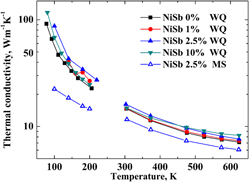Crossref Citations
This article has been cited by the following publications. This list is generated based on data provided by
Crossref.
Mei, Deqing
Wang, Hui
Li, Yang
Yao, Zhehe
and
Zhu, Tiejun
2015.
Microstructure and thermoelectric properties of porous Bi2Te2.85Se0.15 bulk materials fabricated by semisolid powder processing.
Journal of Materials Research,
Vol. 30,
Issue. 17,
p.
2585.
Maskery, Ian
Burrows, Christopher W.
Walker, Marc
Singh, Ravi P.
Balakrishnan, Geetha
Duffy, Jon A.
and
Bell, Gavin R.
2016.
Bulk crystal growth and surface preparation of NiSb, MnSb, and NiMnSb.
Journal of Vacuum Science & Technology B, Nanotechnology and Microelectronics: Materials, Processing, Measurement, and Phenomena,
Vol. 34,
Issue. 4,
Du, Zhengliang
Yan, Mengyi
and
Zhu, Junhao
2018.
Thermoelectric performance of In0.8+yGa0.2Sb (0 ≤ y ≤ 0.06) ternary solid solutions with In excess.
Materials Research Express,
Vol. 5,
Issue. 10,
p.
106301.
Du, Zhengliang
Chen, Xiaolu
Zhu, Junhao
and
Cui, Jiaolin
2018.
Effect of Ga alloying on thermoelectric properties of InSb.
Current Applied Physics,
Vol. 18,
Issue. 8,
p.
893.
Nirmal Kumar, V.
Hayakawa, Y.
Udono, H.
and
Inatomi, Y.
2019.
Enhanced thermoelectric properties of InSb: Studies on In/Ga doped GaSb/InSb crystals.
Intermetallics,
Vol. 105,
Issue. ,
p.
21.
Du, Zhengliang
He, Jian
Chen, Xiaolu
Yan, Mengyi
Zhu, Junhao
and
Liu, Yamei
2019.
Point defect engineering in thermoelectric study of InSb.
Intermetallics,
Vol. 112,
Issue. ,
p.
106528.
Du, Zhengliang
Song, Sizhe
and
Sun, Xiaohui
2021.
Thermal conductivity reduction in GaSb1-Te (0 ≤ x ≤ 0.12) thermoelectric materials.
Physica B: Condensed Matter,
Vol. 609,
Issue. ,
p.
412914.
Zhang, Xiong
Lu, Wei
Zhang, Yu
Gu, Haoshuang
Zhou, Zizhen
Han, Guang
Zhang, Bin
Wang, Guoyu
and
Zhou, Xiaoyuan
2021.
Band convergence and thermoelectric performance enhancement of InSb via Bi doping.
Intermetallics,
Vol. 139,
Issue. ,
p.
107347.
Lu, Zhongtao
Huang, Ben
Li, Guodong
Zhang, Xiaolian
An, Qi
Duan, Bo
Zhai, Pengcheng
Zhang, Qingjie
and
Goddard, William A.
2021.
Shear induced deformation twinning evolution in thermoelectric InSb.
npj Computational Materials,
Vol. 7,
Issue. 1,
Lourdhusamy, Vinothkumar
Chen, Jeng-Lung
Paulraj, Immanuel
Hsu, Liang-Ching
Li, Yan-Yun
Yang, Tzyy-Schiuan
Prabu, K. Veera
and
Liu, Chia-Jyi
2022.
Enhanced thermoelectric performance of polycrystalline InSb1−xBix by using isoelectronic substitution on the Sb site.
Journal of Alloys and Compounds,
Vol. 920,
Issue. ,
p.
165949.
Lu, Zhongtao
Zhai, Pengcheng
Ran, Yongpeng
Li, Wenjuan
Zhang, Xiaolian
and
Li, Guodong
2022.
Enhancement of mechanical properties of InSb through twin boundary engineering.
Scripta Materialia,
Vol. 215,
Issue. ,
p.
114734.
Xin, Jiwu
Li, Wang
Li, Sihui
Tao, Yang
Xu, Tian
Luo, Yubo
Jiang, Qinghui
Wei, Lei
and
Yang, Junyou
2022.
Two-dimensional layered architecture constructing energy and phonon blocks for enhancing thermoelectric performance of InSb.
Science China Materials,
Vol. 65,
Issue. 5,
p.
1353.
Wang, Qing
Li, Zhiliang
Xu, Longxiang
Jiang, Tianwen
Wang, Jianglong
Qian, Xin
and
Wang, Shufang
2022.
Multiple effects result in significantly improved thermoelectric figure-of-merit of InSb semiconductors via embedding metastable Ag/Pt nano particles.
Materials Today Physics,
Vol. 27,
Issue. ,
p.
100818.
Adam, A.M.
Khalil, H.F.
Diab, A.K.
El-Hadek, M.A.
Ataalla, M.
and
Ibrahim, E.M.M.
2023.
Preparation and thermoelectric properties of InGaSb/Ag-nanoparticles.
Vacuum,
Vol. 215,
Issue. ,
p.
112386.
Jesenovec, Jani
Zawilski, Kevin
Alison, Peter
Meschter, Stephan J.
Saha, Sambit K.
Sepelak, Andrew J.
and
Schunemann, Peter G.
2024.
Controlling morphology of NiSb needles in InSb through low temperature gradient horizontal gradient freeze.
Journal of Crystal Growth,
Vol. 626,
Issue. ,
p.
127440.
Abaker, M.
Ahmed, Nazar Elamin
Saad, A.
Khalil, H.F.
Ibrahim, E.M.M.
and
Adam, A.M.
2024.
Thermoelectric properties of Ga-doped InSb alloys.
Vacuum,
Vol. 219,
Issue. ,
p.
112761.
